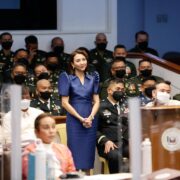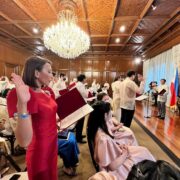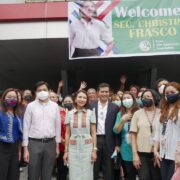Balikbayan Magazine’s one-on-one conversation with the Officer-in-Charge of the Tourism Promotions Board of the Philippines
 01 Based on 2016’s travel and tourism statistics, what were the challenges we need to improve on? And how?
01 Based on 2016’s travel and tourism statistics, what were the challenges we need to improve on? And how?
The largest concern is to accelerate the transport infrastructure program particularly in improving and expanding our international airports by enhancing capacities, modernizing travel facilities in the terminals and streamlining airport operations. These developments will greatly facilitate the growth of tourism both from foreign visitors as well as domestic travel. Said major projects consists of the construction of a new terminal at the Clark Int’l airport to service Central Luzon and Metro-Manila, the current expansion program for Cebu-Mactan Int’l Airport which will enable it to process 15 million passengers annually, the ongoing enhancement of Kalibo International Airport and the expansion of the Caticlan Airport to enable it to handle international flights for Boracay, the improvements being introduced to convert the Puerto Princesa Airport to an international gateway, among others. All these plus the operationalization of the new airports in Daraga, Albay and Panglao, Bohol by 2020 augurs well in terms of not only growth in tourist volume but in spreading the economic benefits across the archipelago.
While the infra projects are ongoing, DoT, TPB and the private sector will have to start building demand to the destinations being serviced by the planned international gateways, that is by introducing tour programs in said areas, promoting them and of course encouraging air carriers to y directly to these destinations, initially by developing charter flights.
In the maritime side, the improvements of identified seaports in support of our cruise industry, likewise is a priority infrastructure program. Northern Luzon, particularly the ports of Curimao and Salomague in the Ilocos provinces as well as Subic have been identified by international cruise lines as important ports of call that can be developed. Central Visayas potential for cruise operations are hedged on port improvements in Puerto Princesa, Coron for Palawan, Mactan for Cebu Cagban and Caticlan for Boracay.
02 What are 2016 most successful projects/events and what have we learned from them?
Asean Tourism Forum, Philippine Travel Exchange, Madrid Fusion Manila, Travel Blog Exchange Asia Paci c 2016 (TBEX) and World Street Food are considered successful events we handled. We are also supporting Travel Tour Expo, Philippine Travel Mart and National Association of Independent Travel Association (NITAS) events.
03 What’s TPB’s vision/goals for 2017?
Tourism Act of 2009 spelling out the reorganization of TPB and its mandate. On the short term, the immediate goal will be to strengthen the partnership with the private sector particularly in the promotional effort; this will include both international markets and domestic tourism. TPB plans to rollout the road map for the development of the MICE sector with special focus on Asia Paci c regional events but with North America also for attendance promotions. It shall lend support to efforts being undertaken to expand long stay, retirement and medical tourism as well.
04 What regions, or specific places, TPB wants to highlight for 2017?
In terms of destination development and marketing, we will be guided by the improvement of air and sea accessibility and therefore TPB will push sites and destinations that will be serviced by the new gateways anchored on soft and hard adventure activities and history and culture programs. We are not forgetting the capital city as Manila will spearhead the MICE promotions campaign complemented by Entertainment City as a lifestyle destination.
05 How aggressive is TPB in its role to promote the country? What’s their target tourist count for 2017 or in the next five years?
TPB and its private sector members will be adopting a very pro-active role in country promotions across the broad spectrum of tourism products. We mentioned nature and culture: diving, trekking, surfing, country and mountain biking among others. Farm tourism right now is being developed while our partnership with DENR, NHI, NCCA, through DOT will open up opportunities to visit such heritage sites and nature parks like Mt. Hamaguitan in Surigao and the Tamaraw Reserve in Mindoro. We will continue to push pro- grams in our top 10 markets but be more aggressive in Mainland China, India, the Middle East and of course in our ASEAN neighbors particularly Indonesia, Vietnam and Thailand. Partnering with air carriers will a a crucial strategy to be pursued.
06 Is TPB working with other government agencies to address the issue of transportation (land, sea, air, etc.) to improve tourist travel? How does it see the bigger picture in terms of modern traveling? Where does it want to position the country in the global list of travel spots?
“We will work closely with the DOT and its other attached agencies : TIEZA for example, in terms of investment promotions for their flagship Tourism Enterprise Zones; we support the convergence and joint programs with DOTr for more air routes, DENR for ecotourism, DOH for medical tourism, etc.
07 Palawan was recently hailed as the best beach in the world by Conde Nast Traveler Magazine. How will it affect the tourism in the province and how will TPB use this privilege to sustain the recognition as well as promote other areas?
Palawan is a special case considering the ongoing expansion program of the Puerto Princesa International Airport, we foresee very positive results in introducing its destinations to the traveling public. More focus has to be given to “ground facilities and services” such as more quality and standardized accommodation units, land traffic management, better quality coasters and vans and international standards services from housekeeping to eco tour guides. Essentially it means working with the LGUs and the community stakeholders to make sure development is sustainable and that the destination delivers a pleas- ant and memorable experience.
08 In terms of social media marketing, how are we promoting the country in terms of trends? Most countries use brand ambassadors like Hollywood stars and icons, have we done something similar?
We await directions from the DOT as to how to proceed with the umbrella campaign and the current branding efforts. The latest marker researches commissioned by DOT underscore the expanding reach of web-based technology which means we should strive for a larger presence in travel web sites, booking engines, blogs and other social media platforms… and not only those in English! Said researches also score the importance of Word of Mouth and so we intend to support the efforts of spreading the “Culture of tourism” as part of reaching out to host communities.
09 What’s the biggest advantage of the Philippines compared to other Asian countries with probably similar resources? And how will it help in our tourism?
Said market research elicited these findings from travellers who have been to the country: the largest asset is has is the warm and hosting culture of the Filipino especially out there in the provinces and their ease in the use of English.
10 What is TPB’s vision in promoting the Philippines? And how it differs from other top destinations in the world?
While volume of arrivals and domestic travellers seem to be the traditional gauge of how successful a tourism industry is, let us not forget that economic benefits must be spread to the local people, that we deliver a safe and pleasant experience to our visitors and at the same time respect and enhance our natural and social environment.






